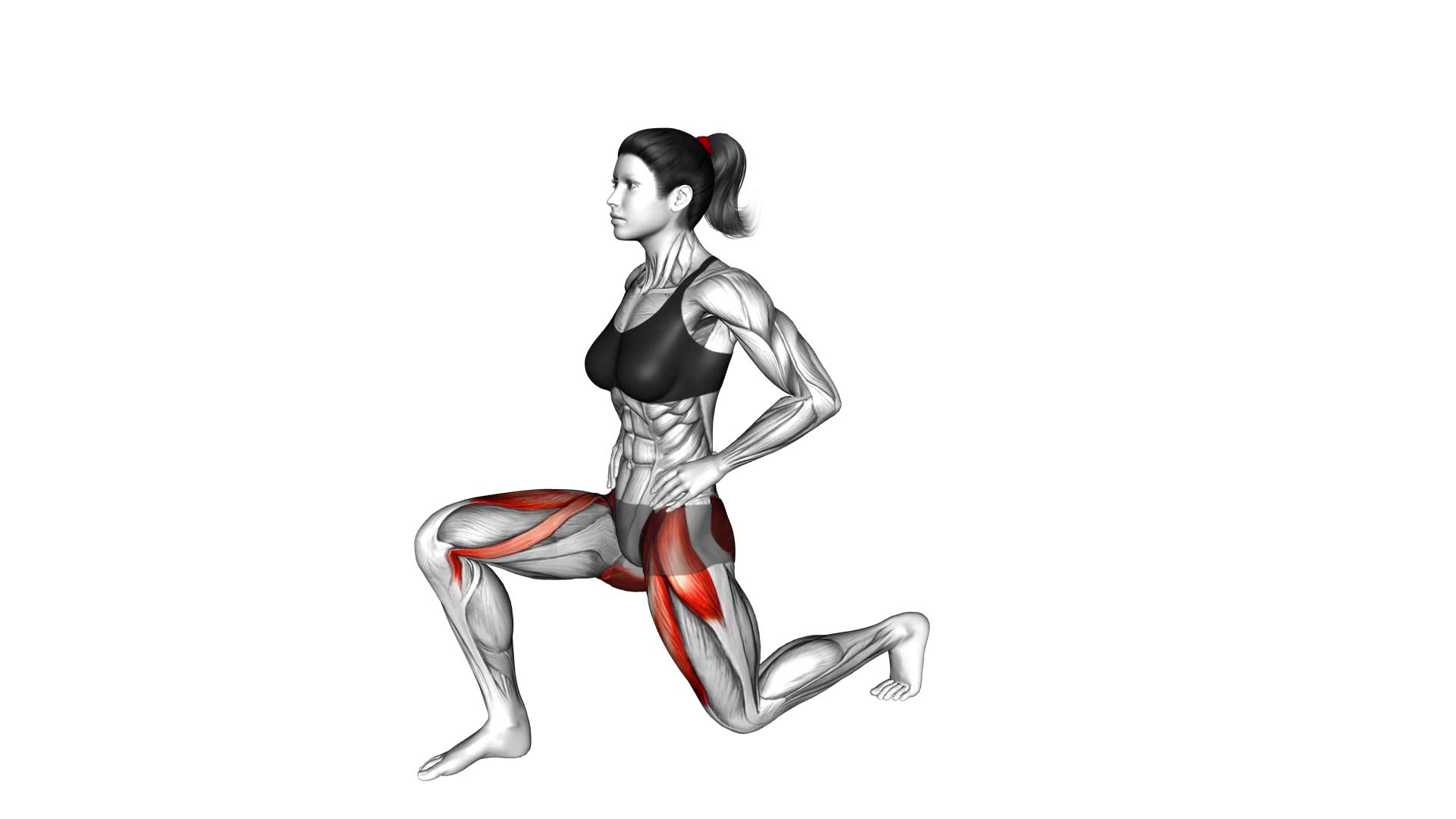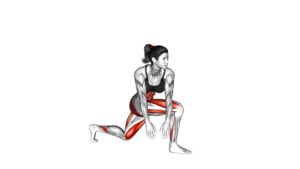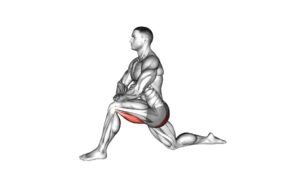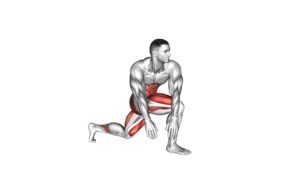Kneeling Hip Flexor Stretch (female) – Video Exercise Guide & Tips

Are you looking to improve your flexibility and strengthen your hip flexors?
Watch This Exercise Video
In this video exercise guide, we'll show you how to properly perform the kneeling hip flexor stretch.
By following our tips and watching the demonstration, you can ensure you're getting the most out of this exercise.
Whether you're a beginner or looking for variations to challenge yourself, we've got you covered.
Get ready to stretch and strengthen those hip flexors!
Key Takeaways
- Increased flexibility in the hip flexor muscles
- Improved posture and reduced lower back pain
- Enhanced athletic performance by improving hip mobility
- Alleviation of tightness and discomfort in the hip area
Benefits of the Kneeling Hip Flexor Stretch
You can experience increased flexibility and improved range of motion in your hip flexors by regularly performing the kneeling hip flexor stretch. This stretch specifically targets the muscles in the front of your hips, which can become tight and restricted due to prolonged sitting or a lack of regular exercise. By incorporating this stretch into your routine, you can alleviate tightness and improve your hip flexibility.
Stretches for tight hip flexors, such as the kneeling hip flexor stretch, are essential for maintaining healthy hip joints and preventing discomfort or pain. When your hip flexors are tight, it can affect your posture, alignment, and overall movement. Over time, this can lead to imbalances in the body and increase the risk of injury.
To perform the kneeling hip flexor stretch, start by kneeling on one knee with the other foot planted firmly on the ground in front of you. Keeping your back straight, gently lean forward, pushing your hips forward until you feel a stretch in the front of your hip. Hold this position for 20-30 seconds, then switch sides and repeat.
Proper Form and Alignment for the Stretch
To ensure proper form and alignment for the kneeling hip flexor stretch, maintain a straight back and gently lean forward, pushing your hips forward until you feel a stretch in the front of your hip.
Here are four important tips to keep in mind:
- Engage your core: As you perform the stretch, remember to engage your core muscles by pulling your belly button toward your spine. This will help stabilize your spine and maintain proper alignment throughout the exercise.
- Keep your chest lifted: Avoid rounding your shoulders or collapsing your chest. Instead, focus on keeping your chest lifted and open. This will help prevent unnecessary strain on your lower back and ensure an effective stretch.
- Modify the stretch if needed: If you have tight hip flexors or limited mobility, you may need to modify the stretch. You can place a cushion or folded towel under your back knee for added support or perform the stretch while standing with one foot elevated on a step or block.
- Listen to your body: Pay attention to how your body feels during the stretch. If you experience any pain or discomfort, ease off the stretch and consult with a healthcare professional. It's important to prioritize safety and always work within your own limits.
Tips for Beginners to Modify the Stretch
Beginners can modify the kneeling hip flexor stretch by using a cushion or folded towel for added support under their back knee. This modification helps to reduce discomfort and pressure on the knee joint, making the stretch more accessible for those with limited flexibility or knee issues. Placing the cushion or towel under the knee provides a soft surface to support the body weight and allows for a more comfortable stretch.
Another modification for beginners is to perform alternative stretches that target the hip flexors. Instead of the kneeling hip flexor stretch, beginners can try the standing hip flexor stretch. To do this, stand with one foot in front of the other in a lunge position. Keep the back leg straight and the front knee bent. Gently lean forward, feeling a stretch in the hip flexor of the back leg. Hold the stretch for 20-30 seconds and then switch sides.
By using a cushion or folded towel and exploring alternative stretches like the standing hip flexor stretch, beginners can modify the kneeling hip flexor stretch to suit their individual needs and abilities. These modifications help to ensure a safe and effective stretching routine.
Now let's move on to the next section and discuss common mistakes to avoid during the stretch.
Common Mistakes to Avoid During the Stretch
One common mistake to avoid during the kneeling hip flexor stretch is rushing through the movement without proper form and control. To ensure you're getting the most out of this stretch and avoiding injury, here are four common mistakes to watch out for:
- Lack of proper alignment: It's important to maintain proper alignment throughout the stretch. Keep your front knee directly above your ankle, and avoid letting it drift forward. Also, make sure your back knee is directly under your hip. This will help target the hip flexors effectively.
- Overarching the lower back: Many people tend to arch their lower back during this stretch, which can put unnecessary strain on the spine. Instead, engage your core muscles and maintain a neutral spine position.
- Holding your breath: Remember to breathe throughout the stretch. Holding your breath can cause tension in your muscles and limit the effectiveness of the stretch. Inhale deeply as you lower into the stretch, and exhale as you come out of it.
- Neglecting the importance of a warm-up: Before performing the kneeling hip flexor stretch, it's crucial to warm up your muscles. This helps to prevent injury and ensures that your muscles are ready for the stretch.
Variations and Progressions of the Kneeling Hip Flexor Stretch
Try incorporating different variations and progressions of the kneeling hip flexor stretch to challenge your muscles and deepen the stretch. Advanced variations can help improve flexibility and target specific areas of the hip flexors.
One variation is the kneeling lunge stretch with a twist. Start in a kneeling lunge position with one foot forward and the other knee on the ground. Place your hands on your hips and twist your torso towards the front foot. This variation adds a rotational component to the stretch, targeting the obliques and increasing the stretch in the hip flexors.
Another advanced variation is the kneeling hip flexor stretch with a pelvic tilt. Begin in a kneeling lunge position and engage your core. Tilt your pelvis forward, squeezing your glutes and feeling a deeper stretch in the hip flexors. This variation adds an extra challenge by incorporating core engagement and pelvic alignment.
To further progress the stretch, you can use an elevated surface such as a step or bench. Place one foot on the elevated surface and lunge forward, keeping the back knee on the ground. This variation increases the range of motion and intensity of the stretch.
Incorporating these advanced variations into your kneeling hip flexor stretch routine will help improve flexibility and target different areas of the hip flexors, allowing for a more comprehensive stretch. Remember to listen to your body and only progress to advanced variations when you feel ready.
Frequently Asked Questions
How Often Should I Perform the Kneeling Hip Flexor Stretch?
To get the most benefits from the kneeling hip flexor stretch, it's important to perform it regularly. Aim for at least three times a week.
This stretch helps to lengthen and loosen your hip flexor muscles, improving flexibility and reducing tightness in the hips.
Remember, there are different variations of this stretch that you can try to target different areas of the hip flexors.
Regular practice will help you see improvements in your hip mobility and overall flexibility.
Can the Kneeling Hip Flexor Stretch Help With Lower Back Pain?
The kneeling hip flexor stretch can help with lower back pain by improving overall flexibility. It targets the hip flexor muscles, which can become tight and contribute to back discomfort.
Performing this stretch regularly can help to alleviate tension in the lower back and improve mobility.
If you have limited mobility, you can modify the stretch by using a support, such as a yoga block, to elevate your front leg.
Always listen to your body and consult with a professional if needed.
Is It Normal to Feel a Stretching Sensation in My Quadriceps During the Stretch?
Yes, it's normal to feel a stretching sensation in your quadriceps during the kneeling hip flexor stretch. This stretch is designed to target and improve hip flexor flexibility, which can affect the quadriceps.
As you lean forward, you may feel a gentle pull in your quadriceps. This is a sign that the stretch is working and targeting the intended muscles.
Just make sure to listen to your body and stop if you feel any pain.
Can the Kneeling Hip Flexor Stretch Improve My Athletic Performance?
The kneeling hip flexor stretch can definitely improve your athletic performance.
By improving flexibility in your hip flexors, you can increase your range of motion and stride length, which can enhance your running, jumping, and agility.
Additionally, this stretch can help prevent injuries by reducing muscle imbalances and tightness in the hip area.
Incorporating the kneeling hip flexor stretch into your routine can have a positive impact on your overall athletic abilities.
Are There Any Contraindications or Precautions to Be Aware of Before Attempting the Kneeling Hip Flexor Stretch?
Before attempting the kneeling hip flexor stretch, it's important to be aware of any contraindications or precautions. Understanding these can help prevent any potential injuries or complications. Always consult with a healthcare professional if you have any pre-existing medical conditions, such as hip or knee injuries, that may be aggravated by this stretch.
Additionally, if you experience any pain or discomfort while performing the stretch, stop immediately and seek guidance from a qualified professional.
Conclusion
In conclusion, the kneeling hip flexor stretch is a beneficial exercise for improving hip flexibility and reducing tightness.
By maintaining proper form and alignment, beginners can modify the stretch to suit their needs. It's important to avoid common mistakes such as arching the back or overstretching.
Additionally, variations and progressions can be added to challenge oneself further.
Incorporating this stretch into your routine can help improve overall mobility and prevent muscle imbalances.

Author
Years ago, the spark of my life’s passion ignited in my mind the moment I stepped into the local gym for the first time. The inaugural bead of perspiration, the initial endeavor, the very first surge of endorphins, and a sense of pride that washed over me post-workout marked the beginning of my deep-seated interest in strength sports, fitness, and sports nutrition. This very curiosity blossomed rapidly into a profound fascination, propelling me to earn a Master’s degree in Physical Education from the Academy of Physical Education in Krakow, followed by a Sports Manager diploma from the Jagiellonian University. My journey of growth led me to gain more specialized qualifications, such as being a certified personal trainer with a focus on sports dietetics, a lifeguard, and an instructor for wellness and corrective gymnastics. Theoretical knowledge paired seamlessly with practical experience, reinforcing my belief that the transformation of individuals under my guidance was also a reflection of my personal growth. This belief holds true even today. Each day, I strive to push the boundaries and explore new realms. These realms gently elevate me to greater heights. The unique combination of passion for my field and the continuous quest for growth fuels my drive to break new ground.







